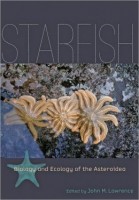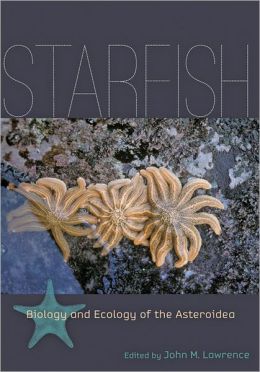 Editor: John M. Lawrence
Editor: John M. Lawrence
Publisher: Johns Hopkins University Press – 267 pages
Book Review by: Deekay Daulat
You may or may not remember your high school biology lessons but starfish belong to the class known as Asteroidea in the subphylum Asterozoa within the phylum Echinodermata in the Animal kingdom. So starfish are commonly called “asteroids” by biologists studying them. Other common echinoderms are: brittle and basket stars, crinoids, sand dollars, sea cucumbers, and sea urchins.
With 30 authors contributing to the 20 chapters of this book, the reader gets an immense amount of information in it on starfish, also called “sea stars.” Over and above the pages where the content is laid out, there are hundreds of sources of additional information listed in the Reference section that is nearly 45 pages long.
Did you know that there are more than 2,000 species of starfish? This question likely arises in the reader’s mind: how do scientists that study starfish keep track of so many species? Well, through categorizing. If you recall further, there is a biological classification system that goes in this sequence: Kingdom, Phylum, Subphylum, Class, Order, Family, Genus, and Species.
So each of these species of starfish belongs to a particular Genus, which in turn belong to a Family, within a given Order in the Class of Asteroidea.
The 20 chapters of this book are divided into two main sections or parts: The first nine chapters are within Comparative Biology and Ecology in Part I; while Integrative Biology or Part II has the other eleven chapters. The comparative part considers the biology and ecology across the class, while the integrative part covers aspects of biology and ecology of individual species or genera.
To give you an overview of Part II, the individual species or genera covered, with an entire chapter devoted to each of them, are: Astropecten, Luidia, Odontaster validus, Acanthaster planci, Oreaster reticulatus, Heliaster helianthus, Pisaster ochraceus, Asterias amurensis, Leptasterias polaris, Coscinasterias, and Echinaster.
What are some of the biological aspects of starfish covered in this book? They are: anatomical and classification differences among different species and genera; chemistry; evolution; and reproduction. Some ecological aspects are larvae ecology, settlement and “recruitment” of asteroids.
There are two valuable features of this book worth pointing out. The first is its detailed charts, sketches and tables containing information on many aspects of starfish biology; and photographs of the starfish, including many full-color ones. The second is the presentation and discussion of the latest findings from research studies on Asteroidea.
Starfish have been around for thousands of years, based on fossil records. So they are of immense interest to paleontologists and biologists studying evolution. But much is not known about them such as aspects of their anatomy, nutrition, physiology and reproduction
Starfish have the unique ability to regenerate body parts, so this book would not only be of interest to echinoderm specialists and marine biologists but also to medical researchers looking to study the possibilities of creating human body parts that are badly needed to enable those who need the parts, to live.
This book is an authoritative compilation of knowledge about starfish from some of the world’s leading experts on starfish. John M. Lawrence has done a great job of sourcing, compiling, organizing and laying out the text and graphics on this interesting subject in this valuable book. He has also written chapter 2 of this book entitled The Asteroid Arm.
John M. Lawrence is professor of integrative biology at the University of South Florida. He is the author of numerous publications, including A Functional Biology of Echinoderms, also published by Johns Hopkins.






